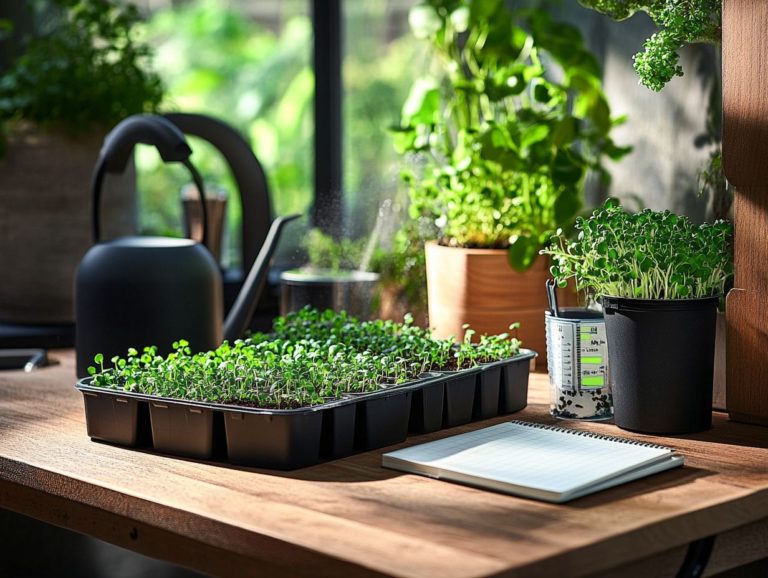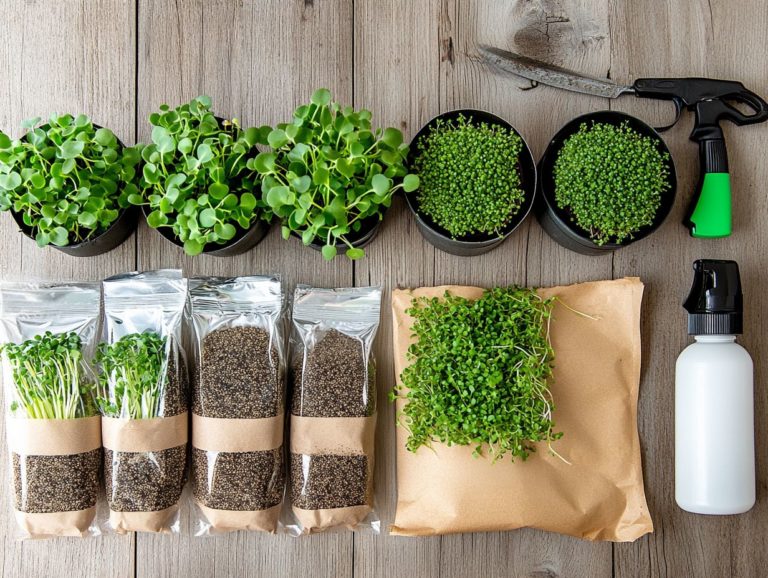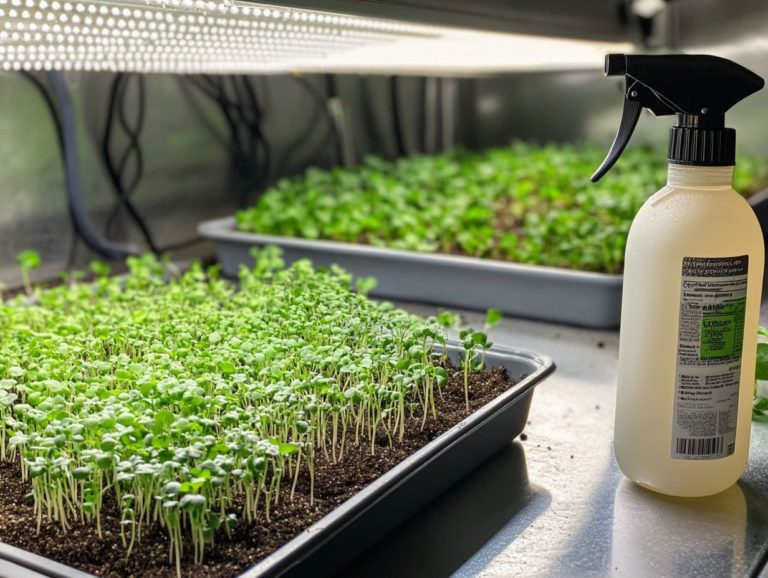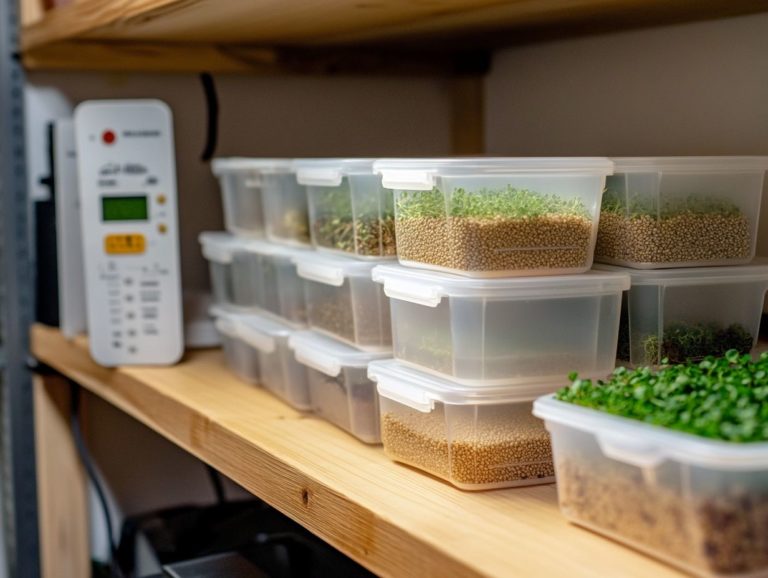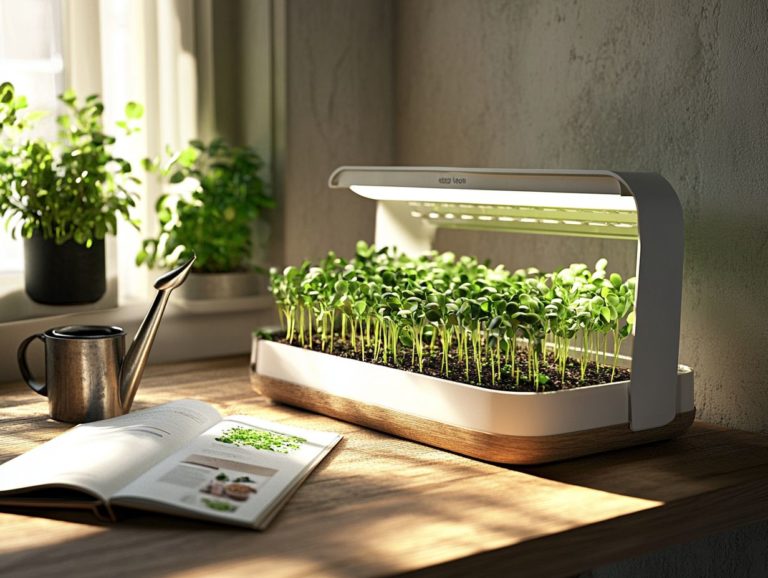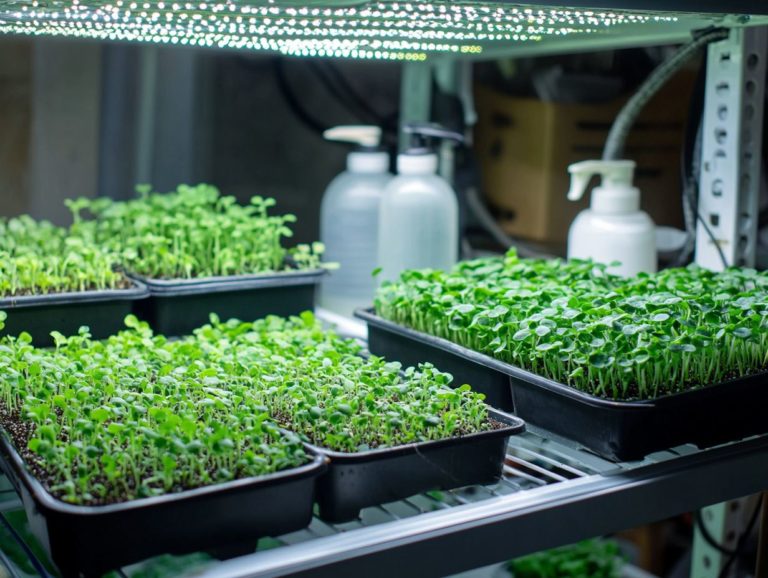How to Choose the Best Hydration Methods for Microgreens
Microgreens are tiny powerhouses of flavor! They are also a coveted choice for home gardeners and chefs alike. These nutrient-rich greens can be cultivated using sustainable practices that promote a clean environment.
To thrive, these delicate greens demand specific hydration techniques tailored to their unique needs. This article delves into what microgreens are and underscores the importance of proper watering for their growth. It covers effective watering methods like bottom watering and top watering.
Factors that influence hydration methods include growing medium, environmental factors, and climate. We will also offer effective watering techniques and essential tips to ensure your microgreens flourish.
Whether you re a seasoned gardener or just starting out, grasping these essentials will empower you to cultivate vibrant, healthy microgreens with confidence. Maximize their growth stage and improve your watering practices!
Contents
- Key Takeaways:
- Understanding Microgreens and Their Water Needs
- Factors to Consider When Choosing Hydration Methods
- Hydration Methods for Microgreens
- Tips for Maintaining Proper Hydration Levels
- Monitoring and Adjusting Watering Frequency
- Importance of Drainage and Airflow
- Frequently Asked Questions
- Why is choosing the right hydration method important?
- What are the different types of hydration methods for microgreens?
- How do I determine which hydration method is best for my microgreens?
- Should I use tap water or filtered water for hydrating my microgreens?
- Can I over-hydrate my microgreens?
- Are there any alternative hydration methods for microgreens?
Key Takeaways:
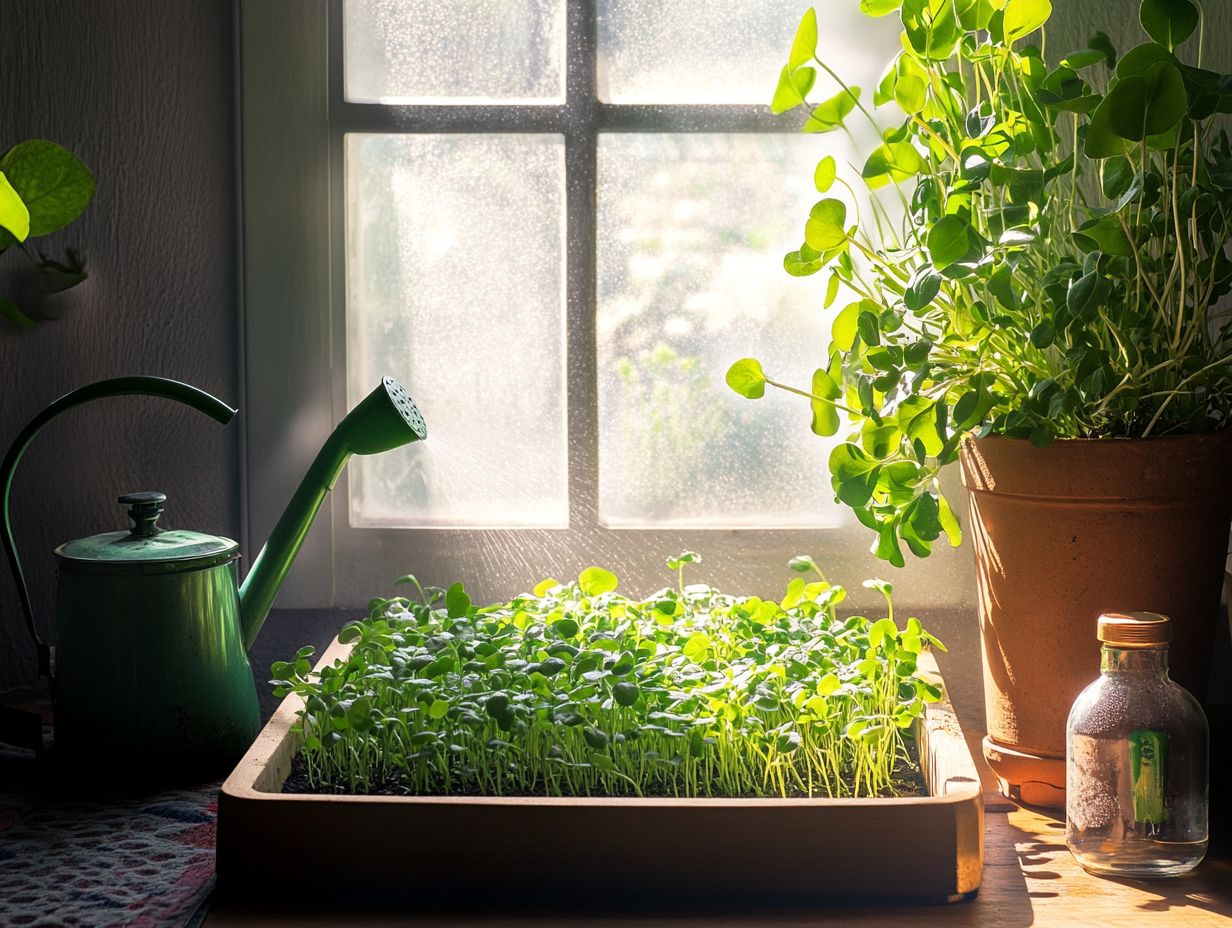
- Proper hydration is crucial for the growth of microgreens. They have specific water needs that must be met, including managing moisture levels and monitoring watering frequency.
- Choose hydration methods based on factors such as the growing medium, climate, and type of microgreen varieties.
- To maintain optimal hydration levels, regularly monitor and adjust watering frequency using tools like a moisture meter. Ensure proper drainage and airflow!
Understanding Microgreens and Their Water Needs
Microgreens are delightful young plants you can harvest right after their first true leaves emerge. They are celebrated for their vibrant flavors, impressive nutrient density, and versatility in many dishes.
Typically grown from seeds of a variety of plants like peas, sunflowers, and basil, they offer a wealth of health benefits. To ensure optimal seedling growth, understanding their specific water needs is essential. Factors such as moisture levels, environmental conditions, and proper watering techniques directly impact microgreens’ health and yield.
In this guide, you ll discover effective ways to manage your watering practices for microgreens. We ll consider various hydration methods and environmental factors along the way.
What are Microgreens?
Microgreens are young vegetables or herbs that you can harvest just after the germination phase. They boast vibrant colors and intense flavors that are hard to resist!
These tiny greens have quickly become favorites among chefs and health enthusiasts alike due to their rich nutrient profiles and remarkable kitchen versatility. Cultivating microgreens is straightforward: simply sow the seeds in a shallow tray filled with a growing medium, place them in a well-lit spot, and ensure they have consistent moisture until they reach about 1-3 inches in height. Common varieties like basil, radish, and arugula each offer unique tastes and nutritional benefits.
Unlike sprouts, the fuller development of microgreens enhances their textures and flavors. They are not just a healthful addition to your meals but also a beautiful garnish. Microgreens can elevate your dishes with their striking aesthetics, turning an ordinary plate into a culinary masterpiece.
Importance of Proper Hydration for Growth
Proper hydration is essential for the growth and health of your microgreens. Inadequate moisture levels can lead to issues like root rot and mold, ultimately affecting your overall yield.
Striking the right balance in watering frequency is crucial. Both overwatering and underwatering can have harmful consequences. Overwatering may suffocate the roots, depriving them of necessary oxygen and encouraging fungal growth, while insufficient moisture can stunt development, resulting in weak seedlings.
By maintaining optimal hydration, you can ensure robust growth, vibrant colors, and enhanced flavors in your microgreens. Addressing common watering concerns like using well-draining soil and monitoring humidity levels will help you achieve that delicate equilibrium.
Ultimately, the well-being of your microgreens depends on mindful watering practices that promote healthy root systems and abundant harvests.
Start growing your microgreens today and elevate your meals in no time!
Factors to Consider When Choosing Hydration Methods
Choosing the right hydration method for your microgreens requires careful thought. Consider the growing medium, climate conditions, and the specific microgreen varieties you re cultivating.
Each factor is very important for ensuring your microgreens thrive.
Growing Medium
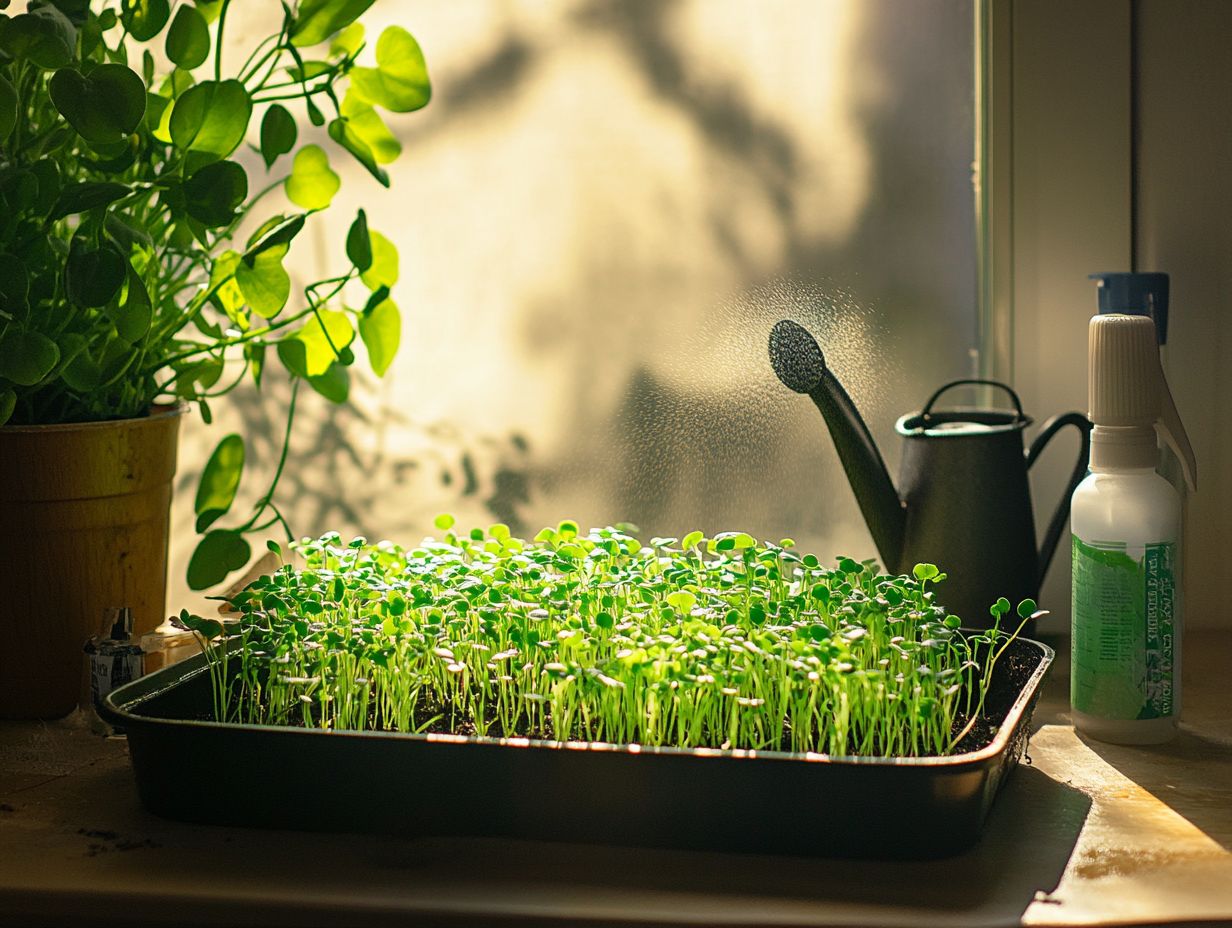
The growing medium significantly affects how you cultivate microgreens. Options like coconut coir, peat moss, and bamboo fiber each have unique advantages.
Coconut coir holds moisture while allowing good aeration, which is essential for healthy roots. Peat moss absorbs more water but may limit drainage, risking waterlogging.
Drainage holes become crucial here. They help manage excess water, preventing soggy conditions that can hinder seedling growth.
These elements together impact your microgreens’ vitality and nutrient uptake, setting the stage for a successful harvest.
Climate and Temperature
Climate and temperature are crucial for managing your microgreens’ hydration. Different conditions can greatly influence moisture levels and evaporation rates.
In warmer climates, seedlings often require more frequent watering. In cooler environments, less frequent hydration may suffice.
Understanding local humidity is vital. High humidity can lessen the need for watering, while low humidity speeds up soil drying.
Proper air movement is essential. Stagnant air can worsen humidity issues and create an environment less ideal for growth.
Balancing these elements leads to optimal conditions for flourishing microgreens. Carefully monitor both climate and indoor environment.
Types of Microgreens
Different microgreen varieties, such as peas, sunflowers, basil, and mustard, have unique watering needs. Understanding these requirements is key for successful growth.
Each type progresses through distinct stages that influence your watering practices. For example, pea microgreens thrive on regular moisture, while sunflowers prefer slight dryness between waterings.
Basil needs consistent hydration for optimal flavor, especially during germination. Mustard greens are resilient but also benefit from steady moisture.
This variability means you ll need to adapt your watering methods. Consider misting for delicate seedlings or bottom watering for varieties that like drier conditions.
Hydration Methods for Microgreens
Excited to nurture your microgreens? Here are some effective hydration methods you can try! Consider bottom watering, top watering, or automated irrigation systems.
Each method ensures consistent moisture levels while protecting your delicate seedlings from unnecessary disturbance.
Bottom Watering
Bottom watering is a great way to keep your microgreen trays moist. This method allows the soil to absorb water from the bottom while keeping the surface dry.
This technique encourages strong root growth as plants reach deeper for water. It also reduces the risk of mold by keeping the upper layers dry.
To use bottom watering, ensure your trays have drainage holes. A shallow tray filled with water can help maintain moisture without soaking the top layer.
Misting
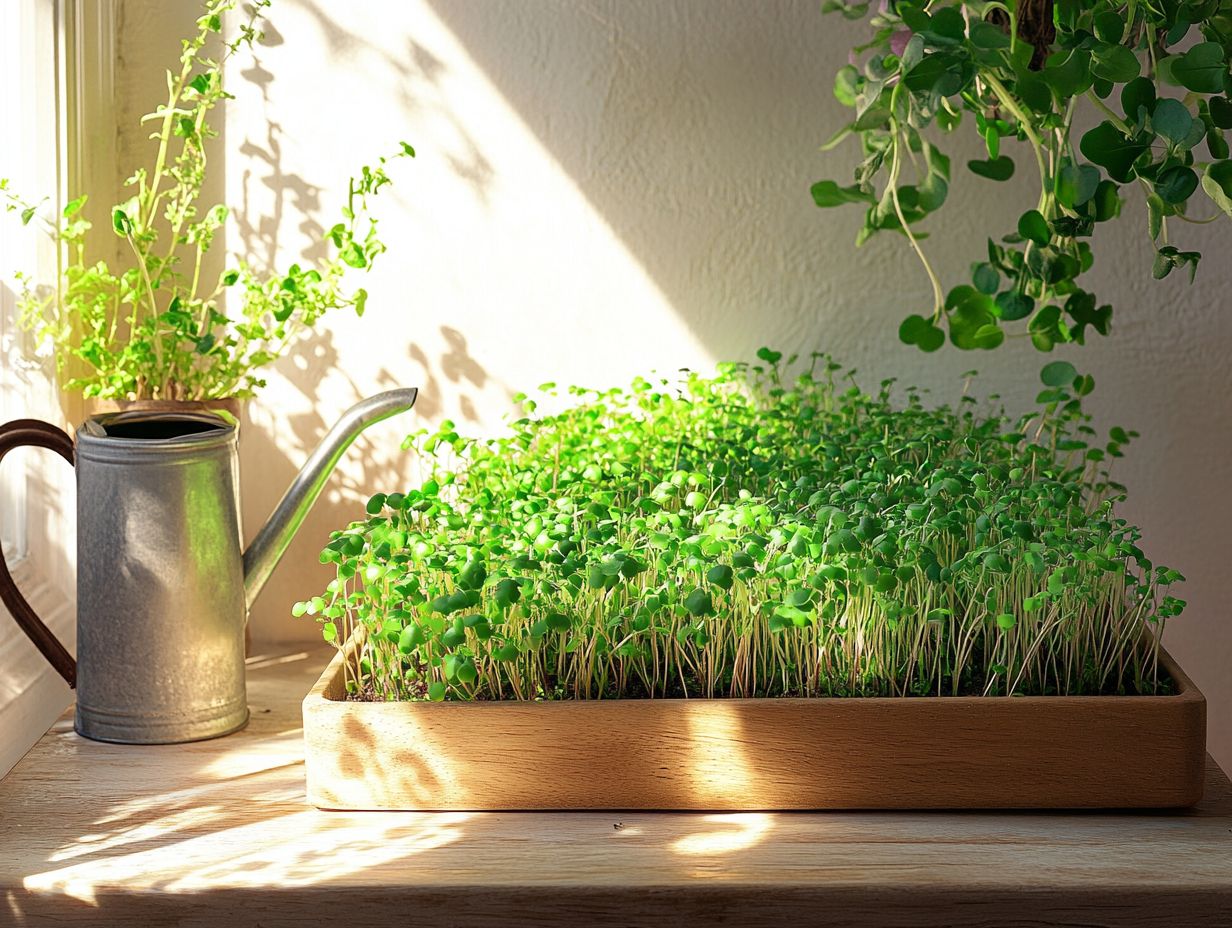
Misting involves spraying a fine mist of water on the surface of microgreens. This provides the humidity they need during early growth.
This gentle moisture promotes growth and helps keep the soil from drying out too quickly. Mist your microgreens once or twice a day, adjusting based on temperature and humidity.
Using a spray bottle or an automatic misting system ensures even moisture. This helps your microgreens thrive while avoiding oversaturation, which can cause mold.
Hydroponics
Hydroponics lets you grow microgreens without soil, using nutrient-rich water instead. This method gives you better control over the growing environment.
By maintaining proper moisture levels, you can avoid overwatering or underwatering your plants. This approach helps your microgreens grow faster and tastier.
There are various hydroponic systems like Nutrient Film Technique (NFT) or Deep Water Culture (DWC). These systems can be set up to meet different microgreen needs, making hydroponics accessible for all growers.
Other Techniques
In addition to traditional watering methods, consider automated irrigation systems. These systems give you precise control over how much water your microgreens get.
Using timers and sensors saves you time and reduces water waste. Smart systems can adapt to changing weather, making your watering routine easier.
Air movement is key, too. It helps with evaporation and keeps transpiration rates high, ensuring your microgreens stay healthy.
Combine these smart watering practices with good air circulation for vibrant crops!
Tips for Maintaining Proper Hydration Levels
Keeping the right hydration levels for your microgreens is crucial. Regularly monitor and adjust your watering schedule as needed.
Pay attention to drainage and airflow to ensure your plants stay healthy and strong.
Monitoring and Adjusting Watering Frequency
Regularly monitoring moisture levels is crucial for adjusting your watering frequency, especially during the various growth phases of microgreens.
Using moisture meters devices that measure how wet the soil is provides you with precise readings. This ensures that you meet the hydration needs without unintentionally overwatering the soil. These handy devices deliver valuable insights, revealing whether the top layer of soil is dry or if there’s residual moisture lurking beneath the surface.
As the seasons shift, so do the environmental conditions, impacting evaporation rates and the soil’s ability to retain water. For example, during the warmer months, you may find yourself needing to water more frequently to combat the accelerated evaporation. Conversely, the cooler seasons might call for less frequent checks.
Understanding these dynamics enables you to create a personalized watering schedule that aligns seamlessly with the needs of your microgreens. Additionally, knowing how to choose the right soil for microgreen growth can further enhance their development.
Importance of Drainage and Airflow
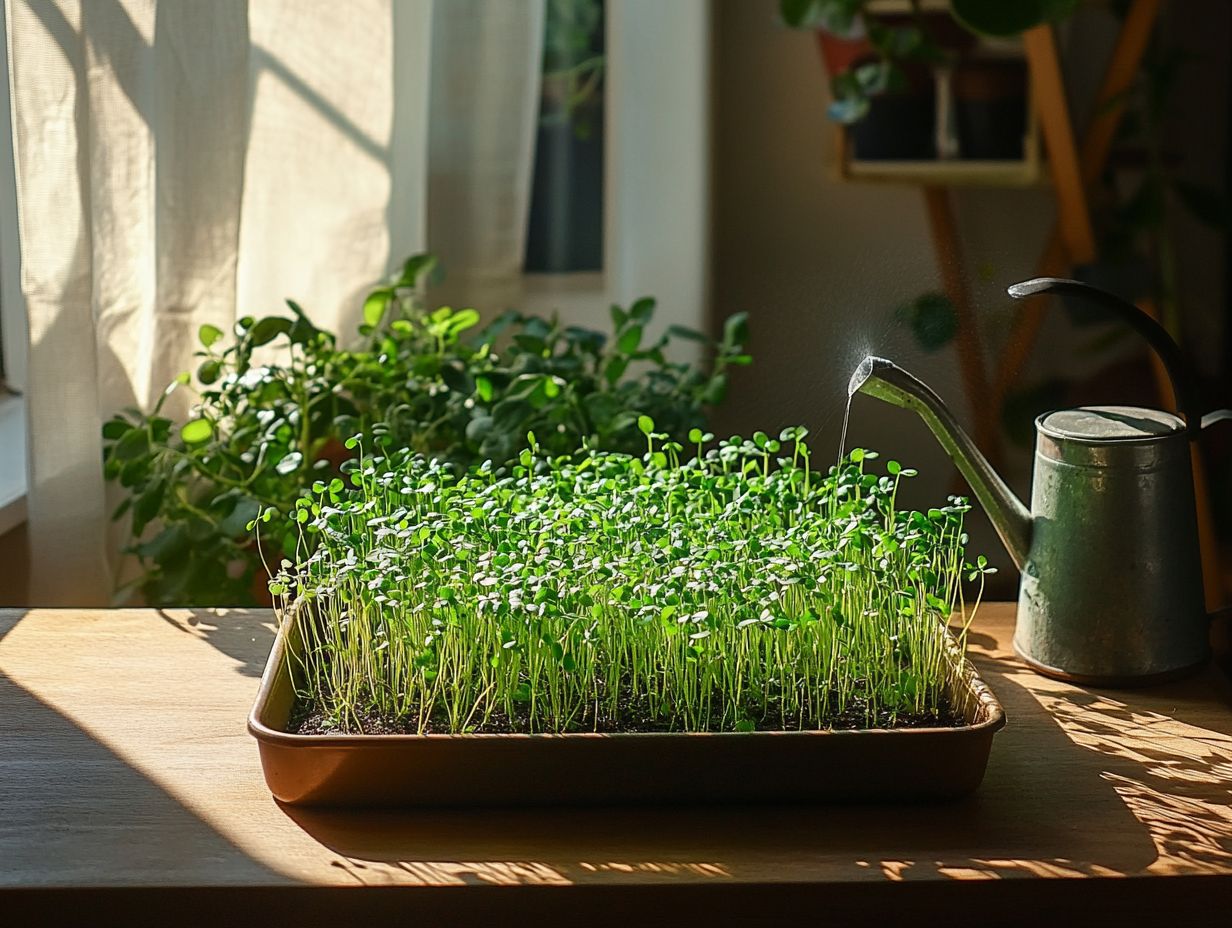
Effective drainage and airflow are essential aspects of your watering practices! These practices prevent excess water accumulation and foster healthy microgreen growth.
These elements are essential for vibrant growth, ensuring that the roots receive the oxygen they need while simultaneously eliminating standing water, which can lead to issues like root rot and mold. To improve drainage, choose containers with strategically placed holes at the bottom, allowing excess water to escape effortlessly. Utilizing lightweight, well-aerated soil mixes will also enhance air circulation within the root zone.
Keep a close eye on humidity levels and ensure adequate spacing between plants to promote airflow. These best practices are key to cultivating a thriving environment. By adhering to these guidelines, you can create a flourishing setting for your microgreens.
Frequently Asked Questions
Why is choosing the right hydration method important?
Choosing the best hydration methods for microgreens is crucial because it directly affects their growth and quality. Proper hydration ensures that the microgreens receive enough water and nutrients to thrive.
What are the different types of hydration methods for microgreens?
The most common hydration methods for microgreens include misting, bottom watering, and top watering. Each method has its own advantages and disadvantages, so it’s important to consider which one is best for your specific situation.
How do I determine which hydration method is best for my microgreens?
The best hydration method for your microgreens will depend on factors such as the type of microgreens, their stage of growth, and your personal preference. It’s important to experiment with different methods and monitor the growth of your microgreens to determine which one is most effective.
Should I use tap water or filtered water for hydrating my microgreens?
It’s best to use filtered water for hydrating microgreens to avoid any potential contaminants or chemicals found in tap water. However, if filtered water is not available, letting tap water sit for 24 hours before using it can help evaporate some of the harmful substances.
Can I over-hydrate my microgreens?
Yes, it is possible to over-hydrate microgreens, which can lead to root rot and other issues. It’s important to find the right balance and not over-water your microgreens, especially when using bottom watering methods.
Are there any alternative hydration methods for microgreens?
Yes, there are alternative hydration methods such as hydroponics and using a self-watering system. These methods may require more equipment and knowledge but can be effective for larger scale microgreen production.
Try these tips and share your results with us!

